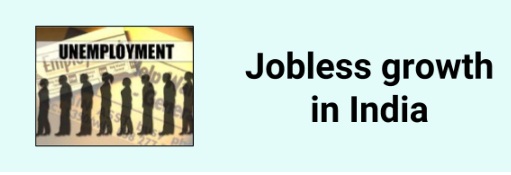Jobless growth in India : Important Topics for UPSC Exams

Jobless growth in India --
- Job creation is the single most important issue that the nation is facing in this decade. India has a leverage of largest young population in the world. However, this demographic dividend need to be exploited.
- As we know that nearly 49% of Indian working population involve in agriculture, though the sector contributes very less in overall GDP of India. The tertiary sector in India is the largest contributor in the overall GDP of India, but the job created by this sector are mostly of formal kind. The chances of inclusion of informal workforce in this sector is very limited.
- As the nation is striving hard for Make in India, the manufacturing sector has the capacity to create jobs that can include large semi-skilled working population of the country. In manufacturing itself, there is a need to focus on certain industries or manufacturing firms like apparel, footwear, furniture, toys and other similar light manufacturing activities. In this chart we can observe that textile sector alone contribute nearly 15% of total GDP. In this way, light industries have the potential for GDP growth along with creating large chunk of jobs with relatively low investment.

- India has two sided benefits of switching to these light manufacturing activities. First of all, these industries can provide employment to large unskilled and semi-skilled labor of India. Secondly, there is also a vacancy exists in these industries due to the shifting of China towards more wage-earning industries. Previously, China was the largest contributor, particularly in apparel industries.
- Besides all these benefits, these light industries are also solving the gender disparity in employment to some extent. Facts show that women are provided with large employment in light manufacturing industries.
Issues--
- Despite all these benefits, India is lacking in developing a strong base for these particular light manufacturing Industries. The reason lies in our policies of bringing these industries, particularly the apparel industry, under the MSME sector. Because of this, our apparel industries remain too small and the product quality is also not at par with big multinational apparel makers.
- However, after the LPG reforms of 1991, the small-scale industries reservation was withdrawn. In spite of this, the investment in these sector remains meagre.
Buy Printed Study Material for UPSC Pre General Studies (Paper-1)
Online Crash Course for UPSC PRE Exam
Way Forward--
Although we try to remove policy and bureaucratic constraints, there remains direct or indirect challenges that need to be addressed soon.
- India need to attract the big international firms that are exiting China. However, it has to face competition from other nations like Vietnam and Bangladesh. These big firms have the best technologies and management know-how of operation in larger scale.
- On policy side, India should make its labor market more flexible in order to attract the big firms in these light manufacturing sectors. In India, the formal sector jobs are highly protected. In conditions like these, firm choses to remain under MSME category in order to avoid these kinds of hindrances.
- There is also a need to increase the movement of imported items and final products that are to be exported. Unnecessary clearance requirements need to be eliminated and the coastal regions should also reduce the delay within hours as occur in exporting giants like Singapore and Hongkong.
- It is also needed that all form of taxes in these industries need to be
rationalized. It is required in order to improve the competitiveness of
light industries.
At the management level, RBI needs to manage the foreign exchange in India.
Conclusion--
- The growth and development of light manufacturing sector, especially apparel, is the new path than India need to follow. The short-term focus should be to support the formation of big international anchor firms in the country. Once these firms will give boost to the nation, more and more local firms get inspiration from them.
MODEL QUESTIONS
Q. When a person shifts from one job to another job, and in between if he may unemployed for some times. Then he is suffering from which type of unemployment--
i. Seasonal unemployment
ii. Cyclical unemployment
iii. Structural unemployment
iv. None of the above
Answer-- iv. None of the above. These kind of questions should be solved only
when you are 100% sure about the answer.
In frictional unemployment, a person becomes temporarily unemployed while
shifting from one job to another.
Q. The jobless growth can not satisfy the aspiration of India. How the manufacturing programs like make in India help in generating required employment in India? Discuss.
Answer. Hint--
Introduction—Give certain facts that one can learn from eco. Survey. Facts
help you to convince the examiner that mere growth without employment cannot be
inclusive.
Or just start as I do in my article.
Body—Read my article. It helps you to understand the problem. Make in
India is about manufacturing sector development in India. However, only high
skill manufacturing cannot not solve the problem of employment as most of
India's workforce are unskilled or semi-skilled.
Further, talk about light manufacturing. How they are helpful in job creation.
We have model of China. Talk about indigenous problems (prefer points only)
Conclusion— Here talk about sustainable development goals; in which job
creation is a big target that India need to fulfill till 2030. Among other
alternate ways, policy support to these light manufacturing sectors may help
creating jobs for a large semi-skilled workforce for India.

